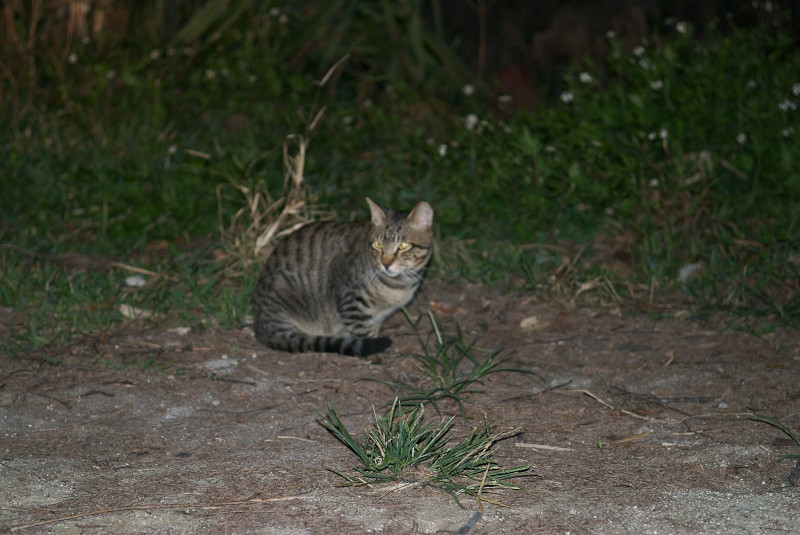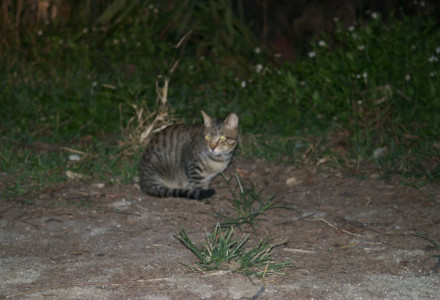
Photo: sota
CCL: https://bit.ly/3lKKoSw
Iriomote Cat Facts
- This marvelous wild feline is most frequently referred to by the descriptive and informative common name of Iriomote Cat. That’s the english language name for it, though. In Japanese, it’s known by the very similar moniker of Iriomote-yamaneko.
- In scientific circles, however, it’s better known by its technical title. That term, though, is extremely hard for the layperson to pronounce. That’s because this beautiful creature bears the tongue-twisting formal title of Prionailurus bengalensis iriomotensis.
- The intriguing animal received that formal moniker due to the efforts of the Japanese zoologist, Yoshinori Imaizuni. He accomplished the first official recognition of the mammal as a specific subspecies of the much better known Leopard Cat.
- The population of the remarkable Iriomote Cat, already extremely small, seems to be falling rapidly. That unfortunate trend also appears to hold true throughout the entirety of its natural range. Recent estimates place its population at only 100 individuals.
- The IUCN thus now lists this incredible feline as Critically Endangered. That lamentable status is reflected on the organization’s published Red List of Threatened Species. Fears exist that the creature may soon disappear from the earth completely.
- It faces many threats in addition to its own limited numbers. Given its extremely limited natural range, habitat loss poses a proportionately higher danger than for some species. The animal also now faces the danger posed by ongoing climate change.
Related Articles
Scottish Wildcat Pallas Cat Flat Headed Cat
Public Domain Image
Iriomote Cat Physical Description
The beautiful Iriomote Cat certainly catches the eye of anyone fortunate enough to encounter one. It does so for several reasons, though. Its appearance is intriguing, since it looks much like a common house cat. But its sheer size remains slightly greater than these.
Much like most felines, though, it does display a certain degree of sexual dimorphism. In its case, this physiological characteristic manifests itself in terms of pure size. That’s true since males of the species attain slightly larger average phsyical measurements.
The males reach an average head-and-body length of approximately 22 – 24 in (55 – 60 cm). Their female counterparts, however, grow to an average of 20 – 22 in (50 – 55 cm). Among individuals of both genders, the tail attains a length from between 9.1 – 9.4 in (23 – 24 cm).
Weights also differ moderately accordingly between the two sexes. Being smaller, the females typically weigh between 6.6 – 7.7 lb (3 – 3.5 kg). The longer-bodied males, though, generally have a mass equaling 7.7 – 10.0 lb (3.5 – 5 kg). So there’s not a significant difference.
The overall body shape of the Iriomote Cat distnguishes it from most of its kin. It has a relatively long, thin body, with comparatively short, thick legs. The shoulders are powerful. It also presents a neck that’s thicker in relation to the rest of the body than most felines.
In appearance, most specimens present a predominantly light brown and dark gray combination. The stomach and underside of each limb, though, show a somewhat lighter shade. Two dark brown spots appear on each cheek, and 5-7 stripes running across the head.
- Kingdom: Animalia
- Phylum: Chordata
- Class: Mammalia
- Order: Carnivora
- Family: Felidae
- Genus: Prionailurus
- Species: P. bengalensis
Public Domain Image
Iriomote Cat Distribution, Habitat, and Ecology
Sadly, the delicate wonder of Nature that’s the Iriomote Cat has an extremely limited habitat range. In fact, that zone of habitation ranks as the smallest endemic area of habitation of any known wildcat. It might surprise some to learn that it’s native to Asia.
Even there, though, the animal only lives within a very tiny geographical area. That appears in a portion of the country of Japan. Yet even there, it lives solely on a single island. That’s the tiny island of Iriomote, measuring just 112 sq mi (290 sq km) in total area.
Further limiting its expanision opportunities is its very specific habitat requirement. The vast majority of known specimens live in one specific ecosystem. That consists of the regions of subtropical forests. That habitat does, at least, cover roughly 90% of the island.
Inside of that area, though, it also displays decided preferences for certain altitudes. The specifically evolved small mammal rarely appears at altitudes in excess of 656 ft (200 m) above sea level. The precise reason for this, however, still eludes its many researchers.
Unlike most related species, the Iriomote Cat appears to be a primarily terrestrial type of wildcat. It will, however, climb trees, and even swim when necessary. It also evolved as nocturnal in nature, with the primary period of activity being during the twilight period.
During the day, the wildcat prefers to remain in caves or hollow trees. As with most related species, it marks its territory. It’s also entirely carnivorous in its eating habits. That diet primarily consists of small varieties of birds, reptiles, fish, amphibians, and crustaceans.
Species Sharing Its Range
Golden Pheasant Feather Starfish Marbled Cat
Check out our other articles on 7 Stunning Pacific Ocean Species, Alligator Snapping Turtle, Sacred Valley, Moon Orchid, Eastern Tiger Swallowtail, Bluespotted Ribbontail Ray

